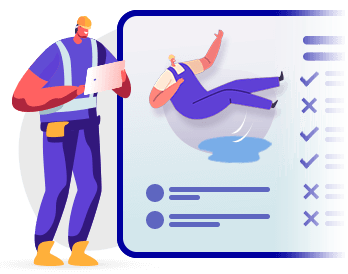How to write an incident report?

Accidents happen, even in the safest workplaces. The real question is: how do you turn these incidents into opportunities for improvement? The answer lies in the power of a well-written incident report.
An incident report isn’t just paperwork—it’s a tool for learning and prevention. By documenting the details, you can uncover the root causes and take action to avoid future mishaps. But how do you write an incident report that truly makes a difference?
In this guide, we’ll walk you through the essentials of crafting an effective incident report. Whether you're new to this or just looking to sharpen your skills, you'll find practical tips and insights to help you write reports that lead to real change.
Table of Contents
- What is an Incident Report?
- Why Are Incident Reports Important?
- When Should You Write an Incident Report?
- Key Elements of an Incident Report
- Step-by-Step Guide to Writing an Incident Report
- Common Mistakes to Avoid
- Best Practices for Writing an Incident Report
- How Safetymint can help in reporting incidents
What is an incident report?
An incident report is a written record of any unexpected event in the workplace. It details what happened, who was involved, and the consequences. The primary purpose is to document the incident accurately, providing a clear account that can be reviewed and analyzed to prevent future occurrences.
An incident report plays a crucial role in understanding what went wrong. By capturing the details of the event, you create a factual record that helps in identifying patterns, determining root causes, and developing strategies to enhance workplace safety.
To be effective, an incident report should include:
Incident Details: A clear description of what happened,
including time, location, and context.
People Involved: Information on everyone present or
affected by the incident.
Impact: The consequences of the incident, such as
injuries or property damage.
Immediate Actions: Any steps taken right after the
incident to manage the situation.
Read on, to learn more about each of these points.
Why Are Incident Reports Important?
Incident reports are vital tools for improving workplace
safety. They provide a clear record of what went wrong,
helping organizations identify and address hazards before
they lead to more serious issues. By documenting incidents,
you can learn from past mistakes and take proactive steps to
prevent future occurrences. This not only protects employees
but also helps in complying with safety regulations and
avoiding legal liabilities.

When Should You Write an Incident Report?
An incident report should be written whenever an unexpected event occurs that affects safety. This includes injuries, near-misses, property damage, or any situation that could potentially lead to harm. Timely reporting ensures that the incident is documented while details are still fresh, allowing for a more accurate and effective investigation.
Key Elements of an Incident Report
A well-crafted incident report includes several essential elements:
Description of the Incident:
This is the core of your report. Clearly describe what happened, including the time, location, and any relevant circumstances. Make sure to stick to the facts, avoiding any personal interpretations or assumptions.

People Involved:
Detail everyone who was present or impacted by the incident. Include their roles and any actions they took during the event. This helps to establish a complete picture of what transpired and who was directly involved.
Consequences:
Outline the immediate outcomes of the incident. This could include injuries, property damage, or operational disruptions. Understanding the impact is crucial for assessing the severity and determining the necessary follow-up actions.
Actions Taken:
Document any immediate steps taken in response to the incident. This might involve first aid, emergency measures, or securing the area. Recording these actions is important for evaluating how effectively the situation was managed and what could be improved in future responses.
These elements ensure that the report is comprehensive, providing all the necessary information for a thorough review.
Step-by-Step Guide to Writing an Incident Report
Common Mistakes to Avoid
When writing an incident report, avoid:
Vague Descriptions:
Avoid being too general or unclear about what happened. Provide specific details and avoid leaving out critical information. Vague descriptions can lead to misunderstandings and hinder the effectiveness of the report.
Emotional Language:
Keep your tone neutral and focused on the facts. Avoid letting emotions influence your writing, as this can skew the report and affect its credibility. Emotional language can distract from the objective nature of the report and reduce its impact.
Overlooking Details:
Small details can be significant, so don’t overlook them. Ensure that all aspects of the incident, even seemingly minor ones, are included. Missing details can lead to incomplete analysis and missed opportunities for improvement.
Delays in Reporting:
Write and submit the report as soon as possible after the incident. Delays can result in fading memories and missing information. Prompt reporting ensures that the details are fresh and accurate, leading to a more reliable and actionable report.
By steering clear of these mistakes, you’ll create a more effective and reliable incident report.
Best Practices for Writing an Incident Report
To write an effective incident report:
Be Objective:
Focus solely on the facts of the incident. Avoid inserting personal opinions or assumptions. Objectivity ensures that the report is a reliable source of information for future analysis and decision-making.

Use Clear Language:
Write in simple and direct terms that anyone can understand. Avoid technical jargon unless necessary, and ensure that your sentences are short and to the point. Clear language helps prevent misunderstandings and makes the report accessible to a wider audience.
Be Thorough:
Cover all relevant details without overloading the report with unnecessary information. Ensure that every important aspect of the incident is captured, from the initial event to the aftermath. Thoroughness is key to creating a complete and useful report.
Review and Revise:
Before finalizing your report, take the time to proofread it. Check for any errors, inconsistencies, or missing information. Revising your report ensures that it is accurate and polished, ready for review by others.
These practices help ensure that your report is accurate, clear, and actionable.
How Safetymint can help in reporting incidents
Safetymint is an online incident management system developed to help organizations manage safety incidents, observations and near misses. It improves your safety culture by getting more people involved in reporting incidents and it enables you to gather the right data to make better decisions.
Instant reporting
Safetymint offers a simple & quick process for reporting incidents, which helps ensure that all necessary details are captured and recorded correctly. Employees can report hazards themselves through their mobile phones or computers anywhere and at any time.
No prior training
Safetymint has an intuitive interface that’s direct and simple enough that anyone with a smartphone or access to a computer can quickly report the incidents — without any prior training.

Overall dashboard view
The safety dashboard allows you to track your leading and lagging indicators at one glance to monitor performance and take corrective action wherever necessary. This will help you develop effective solutions for reducing injuries and improving overall workplace health and safety performance.
Custom investigation workflow
Safetymint includes a 5-step incident investigation process which includes the following steps: Incident reporting, Setting up and investigation team, Root cause analysis, Recommended actions and Review and Closure. This process can be used for both internal as well as external investigations.




